|
|
Post by Dave Homewood on Dec 26, 2019 13:45:37 GMT 12
Here is an interesting piece on the island of Vella Lavella in the Evening Post just after the New Zealand Army landed there to retake it from the Japanese. Has anyone here visited that island? Can anyone confirm the supposed castles?
VELLA LAVELLA
STRANGE FEATURES
RUINS OF STONE CASTLES
O.C. AUCKLAND, This Day. Vella Lavella, the island in the Solomons where New Zealand soldiers have been successfully engaged against the Japanese, was described yesterday by the Rev. A. A. Bensley, of Tauranga, who spent about 13 years on the island, as having between 50 and 60 miles of coastline. The name Vella Lavella, said Mr. Bensley, was not the one by which the island was known to its inhabitants, and was probably of Spanish origin. One of the peculiar features of the island was abundant evidence that it was once peopled by a powerful and ingenious race. Ruins of what might have been stone castles were still to be seen, but the islanders themselves could throw little light on their origin. Wisps of tradition which they had did not take the inquirer beyond stories of great giants of unbelievable strength.
On the east the island faced the great mountainous mass of Kolombangara, also much in the news. The name of this island meant Chief or King of the Seas, from Kolo, water or sea, and Bangara, chief. The invading Allied troops would find easy landing at a point on the south-east of Vella Lavella known as Bilua, Mr. Bensley continued. There was a small but safe harbour and a fine area of cleared ground where in peacetime there was an excellent plantation and the many of a busy mission station. The latter included a large semi-European and well-equipped hospital and several bungalows for the medical and mission staff.
AIRFIELDS AVAILABLE.
At this point it would not be difficult to construct an air strip. Another area where an airfield would be easily made was to be found on an island named Liapari, in the vicinity of Bilua. This was the site of another productive plantation.
"Like most of the Solomon Islands, said Mr. Bensley, "Vella Lavella is clad in forest, except where this has given way to plantations. The island is singularly beautiful and fruitful, and has a variety of scenery and many features peculiar to itself. For instance, the people have an origin that is shrouded in mystery. Their language in no way resembles the languages of the people of adjacent islands, and, ethnologically, the natives of Vella Lavella have an origin different from that of the other Melanesian and Polynesian islanders.
"The bush is full of the native almond, providing the people with quantities of nourishing food. There is also a good deal of thermal activity, especially about an hour's walk through the bush from a place called Paraso. Here there are boiling mud pools in abundance and many holes scratched in the warm earth by the megapode, usually called the bush turkey. The birds deposit their eggs in the warm earth and the eggs are eagerly sought by the natives."
EVENING POST, 15 OCTOBER 1943
|
|
|
|
Post by Dave Homewood on Dec 26, 2019 15:06:58 GMT 12
Another very interesting and harrowing story from Vella Lavella, from the Evening Post, 18th of October 1943
RESCUE UNDER FIRE
NEW ZEALAND PARTY
MINIATURE DUNKIRK
A story of a desperate rescue is told by the N.Z.E.F. war correspondent at Vella Lavella, dated October 3.
Fifty New Zealanders had been invested by a superior Japanese force for six days, with little to eat or drink, when a rescue party arrived in a barge, which stopped 300 yards off the shore, on the edge of-the coral reef.
The besieged men had been surrounded and attacked from four sides while guarding a vital point on the trail leading to the hills beyond the battlefront, had had to abandon their gear, lose contact with their ration supply party, and hold grimly to the task of self-defence. For four days they had stayed near this trail on the hills, rain-soaked and hungry, and sleepless. Shouting Japanese had yelled: "We'll have your blood. Heil Tojo! Heil Hitler!"
"Fit, big, and well-armed" was how our men described the enemy.
In those four days at least six organised attacks had been launched on them. Snipers had sought to pick off our men one by one. The firing had died away only at night. At the end of the third day one officer and two men had set off for help, but on the fourth the remainder moved cautiously downhill to the beach, where they were in sight of any passing barge.
Only friendly barges sailed in these waters. The seas beyond were no safe place for Japanese shipping. On the afternoon of the fourth day a barge did pass, and pin-pointed the New Zealanders' position. The rescue would be hazardous, for here was the focal point of the Japanese lines, so central that when an enemy aircraft dropped rations during Friday evening a parachute fell among the New Zealanders, who enjoyed their first meal in five days from the fish cakes, plums, and oatmeal of the Japanese emergency food packets.
On Saturday, the sixth day, the, barge returned, and the first of the beach party crawled and swam towards it. One man reached the barge, and an officer climbed over the side to help him on. He was shot from the shore as he leaned towards the water. A transport driver who had volunteered to go with the original patrol a week before and had been the life and soul of the besieged party, clambered onboard and manned a machine-gun. He was killed while his first bursts were peppering the bush. The barge could wait no longer.
A GALLANT EFFORT.
Back in our own lines another party was organised. Five men, including two officers, planned to swim ashore behind protective life jackets and haul in a rope by which the wounded at least could be evacuated. The barge moved in again and the five men, vividly recollecting the fate of the first attempt, set out on that perilous coral crossing.
One stopped for a moment on the way to free the rope from the shelf of rock. He was the sole survivor. None ahead of him who came directly into the Japanese fire reached the shore, though a young subaltern from Canterbury, who only two days before had gallantly led a platoon from a dangerous pocket under heavy fire, scrambled to within a few yards of his goal before he fell. The third and successful venture was postponed till nightfall, when selected swimmers from a host of volunteers dragged a rubber dinghy and canoe to the shore. Two barges lay off at the edge of the reef, and though the procession of men took three hours to move from the beach to the barges, every man was safely evacuated before midnight.
The seventh day—the Sabbath—was a day of rest.
|
|
|
|
Post by Dave Homewood on Dec 26, 2019 15:09:34 GMT 12
And this was also from the Evening Post, 18th of October 1943 THEIR FIRST PRIZEJAP SCHOONER CAPTUREDSYDNEY, October 17. A small New Zealand Army patrol captured a Japanese schooner intact at Varuasi, wiped out the crew, and landed the ammunition and stores during the Vella Lavella campaign, reports Winston Turner, "Sydney Sun" war correspondent. The patrol, in the charge of Captain Robert Adams, spotted the Japanese, busy as beavers, in a mangrove swamp, gathering camouflage for the schooner. Splitting the patrol into three parties, Captain Adams detailed one to capture the schooner, another to cover the operation from the other side of the bay, and the third to cut off the retreat of the Japanese. The first party found the whole Japanese crew ashore, boarded the schooner and manned the Japanese guns mounted on the vessel. The covering party then joined the third party in pursuit of the crew, who were on the run. When two Japanese in a canoe were fired on, ten others dashed from the scrub and began swimming out to sea. All were picked off by rifle fire. --------- And here's poor copy of a photo from the Post on the 23rd of Oct 43 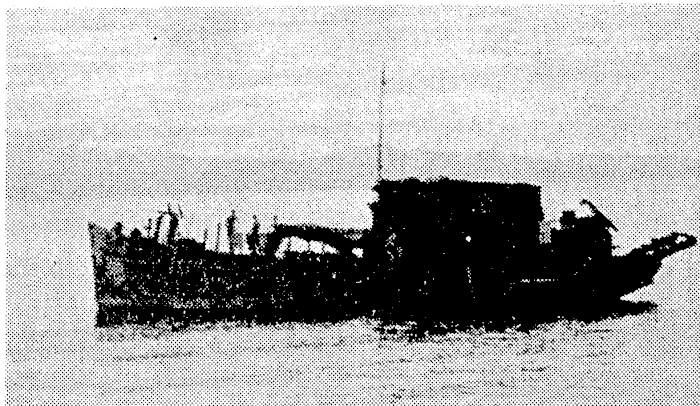 paperspast.natlib.govt.nz/newspapers/EP19431023.2.22.1 paperspast.natlib.govt.nz/newspapers/EP19431023.2.22.1 |
|
|
|
Post by Dave Homewood on Dec 26, 2019 17:09:26 GMT 12
Another article on that horrific venture detailed above, this time with more depth, from the Evening Post dated 22 October 1943.
WEEK IN JUNGLE.
SURROUNDED BY ENEMY.
TERRIBLE EXPERIENCE
N.Z. SOLDIERS'ORDEAL
(Official War Correspondent, N.Z.E.F.)
VELLA LAVELLA, October 12.
Two days before the New Zealanders expected contact with the main body of the Japanese troops in the northwest of Vella Lavella, a party of 50-odd men set out from headquarters to sit on the main trail leading from the enemy positions to the inland hills. Their objective was the top of a long ridge running 1000 yards up from the coast where they were to guard against a possible enemy escape from an enveloping movement of the main Kiwi forces.
A native guide showed two platoons the way in. Though they marched all day Sunday they were still an hour from the trail at dusk, and reached it on the following morning, when they established themselves as firmly as possible on either side of the track and began the patient task of watching and waiting.
The track here was well worn, it had been used by the Japanese trekking into the Marquana Bay-Timbala Bay area ever since the American invasion of the island a month previously and much of the undergrowth had been smashed down, leaving a few clearings in the midst of which grew tall thick trees with flange-like roots, forming natural protective fire positions. Beyond a radius of 20 or 30 yards the undergrowth closed in once more. There was no view through the forest which showed either the sea or any landmarks.
"Here on Monday morning, our native guide saw 40 Japanese close to our objective," one of the members of the party said afterwards. "He was very excited and counted their numbers to me on his fingers. We took two sections up to the track ready to receive the enemy, but by midday, when we were all in position, the approach of between 90 and 100 Japanese froze us to the ground. The enemy came in parties of various sizes. They carried rations and arms and passed within six feet of us without the slightest sign of being conscious of our presence. We could not open fire because we were greatly outnumbered and were split at that stage into two parties, one on either side of the track. We stayed where we were till four o'clock when a clatter in a gully announced a Japanese attack on one platoon.
"The Japanese had made a mass attack, jumping from tree to tree and letting go with all they had with light machine-guns, grenades, and rifles. Our boys held them off with steady rifle fire, and as soon as opportunity presented we got a few bursts into the enemy's flank, which allowed the platoon to rush over to our side of the track, where a united defence was formed."
An officer who was later to guide the men down to the shore and to safety took up the story. "We poured a few magazines into the Japanese and they faded into the trees, losing several dead," he said. "But they surrounded us as we lay on the side or a hill in a perimeter of about 20 by 30 yards, and roared round us, shouting at the top of their voices and belting grenades and machine-gun fire at us. Then they charged again and we fired only when we saw a target, we tossed grenades behind trees and into hollows and the Japanese retired for half ah hour. Then they came again and one man, probably an officer, stood upright to take a look at us. Possibly, he thought we were all dead, and he called something out. But we changed his shouting to a scream, and no other Japanese stood up to get the same fate.
"Fortunately, we were left alone all night, though we could hear the Japanese moving, round us talking now and again. But they did not come in. We were short of rations now. We had to abandon them in the first moments of the Japanese attack. Our haversacks were lost, too, and all that was left was what each man could carry in ammunition. Some did not even have their water bottles."
Next day the Japanese tried again, and every day till Friday, till the New Zealanders were so weak that they knew that remaining in their present position indefinitely would be fatal. On Thursday an officer and two men had made a dash through the Japanese lines to get word to headquarters, but the party left on the ridge could wait no longer. They had taken a sufficiently heavy toll of the enemy to make him extremely cautious. A score of Japanese lay dead outside the Kiwi perimeter.
SUPPLIES RUN OUT.
"So we cut poles for stretchers," the officer said, "and prepared to fight our way to the coast, carrying the wounded with us. We buried some of our dead, but our losses in killed were very few. The morale of wounded and unscathed was wonderful. Not a moan came from any of the wounded men. Those who could walk or help themselves did so. They needed water badly, but we had none to give them. I hoped to find some nearer to the coast. They had had nothing to eat for days.
"On "Friday we fought our way the 1000 yards of jungle track between us and the coast. We had plenty of fighting on the way, but it was better than sitting still and waiting to be picked off and to grow faint from hunger and thirst. It was wonderful how the men responded to the decision to get on the move. They brightened up, laughing as we fought down the hill, giving the Japanese everything they had and taking good care of themselves. We had a few casualties, but nothing compared with what the enemy took.
"At the bottom, still inside the Japanese positions, we hauled stretcher wounded through mangrove swamps of black oozing mud deep to our knees. There wasn't a groan from them. I managed to collect a little water after we formed our new perimeter on the fringe of the bush, enough from a hole I scraped in the mud and from a hollow tree stump to fill three water bottles. Two I reserved for the wounded. One I handed round among the rest. We had 51 in our party then, six of them wounded. When the one bottle had been passed round its allotted 45 men and was coming back to me there was still water in it. That will show the spirit of the men." .
RESCUED BY SEA.
Relief came on Saturday and of the rescue in which six men—five from a rescue party—lost their lives in two abortive daylight attempts, the men who had spent nearly a week in a hell on earth, spoke feelingly. They were sitting on the shore on Saturday night. They could see nothing in the blackness. At 8 o'clock, a noise of barges creeping in from the sea was heard. The noise stopped a matter of 300 yards out. Shallow coral reefs had blocked progress. Remembering the fate of members of the rescue party who had died in trying to reach the shore during the afternoon, the men on shore waited in suspense. The barge engines had stopped. There was no sound. And then six feet from the shore a head appeared and another and the dim outline of a canoe and of a rubber lifeboat. A rope from the barges was secured and the first out were those who had been wounded. They were laid carefully in the lifeboat and the canoe. Their escort took knives to fight off sharks. Then a dozen at a time the rest of the party slid into the water and crawled, and swam to the boats. The perimeter on shore grew smaller till at last just six men armed with grenades remained. They slipped away unmolested. Clothing, watches, and personal gear were left on the shore. Only the soldier's greatest friend, his rifle, tommy-gun, or Bren gun, went with him to safety.
Next evening, resting after their trials, the men of those platoons approached their padre with a request that they hold a short service of thanksgiving at their deliverance. And behind the thatched Methodist Church in the native village of Iringila where before the war New Zealand missionaries took the Gospel to this Solomon island, natives and 50 men listened, in the peace of a Sunday evening, to a simple practical talk on the text of "Greater love hath no man than this that a man lay down his life for his friends,' and joined together in the singing of the Doxology and "Praise God from Whom All Blessings Flow."
|
|
|
|
Post by Dave Homewood on Dec 26, 2019 21:11:55 GMT 12
This one was published in the Evening Post, 29th of October 1943
ISLAND WARFARE
A CAMPAIGN SKETCH
GUNNERS IN THE JUNGLE
The island is mountainous, covered in jungle, and it is almost impossible to cross from one side to the other, writes a New Zealand soldier from Vella Lavella. It rains at least every other day, and it makes a job of it when it starts; talk about making up for lost time. As I write this now l am out for a spell at the gun position, and it seems like home. We arrived at the point where the battle was to start, and from then till now I have walked miles. We had the job of being on the coast, so laid the cable as we went, the wireless being inland. We laid cables for miles; in fact, are still laying it. We did not do much in the early stages, except follow up closely with the infantry. Not long after, we had a job to do and we made a fair job of things. From then on things went better and better.
The shooting has been good, the boys on the guns doing a wonderful job, the signallers excelling themselves under most trying conditions. The troops did wonders.
AT CLOSE QUARTERS.
At night we get very little sleep and all the time one's nerves are on edge. We always sleep in foxholes at night, and if we stop during the day we dig them again. We do the ants, land crabs, and what-nots out of a home. The noise, jungle noise at night, is terrific, and what with firing, etc., we get practically no sleep at all. When we move during the day we have to keep our eyes and ears open all the time. You never can see the little yellow bloke, especially the sniper. Before you know what has happened, he has had a pop at you, and you can't tell where he is, he, of course, having the advantage. Several have whistled in our direction and some have been uncomfortably close. At one stage the Jap was very close to us, and we were directing fire from the front line, bullets screaming all around us and shells whistling overhead and crashing to earth just in front of us. The old Nip was firing at the voice of the officer and signallers at the telephones. Evidently the Nip did not see us, or could not bring his machine-guns on us. After the firing we found a lot of dead Japs, some new, some older. Not a pleasant sight, but nice to know they were Nips. Unfortunately we are not without killed and wounded. Hard when you see chaps you know get killed in attempts to save others. These infantry boys are tough, and I certainly take off my hat to them every time. Wouldn't take their jobs on for quids. We had a tough time, but nothing to these boys on patrol.
"THE JUNGLE STINKS."
The jungle itself stinks. You can't wonder at it, as the ground never sees the sun from one year's end to the other. Twisted vines everywhere, great roots of tremendous trees, everything growing upward for a glimpse of the sun. With all the rain, mud is everywhere, and one is continually ploughing through it. If you come near a Jap bivouac area you soon smell it as it stinks worse than the jungle. We didn't have clothes or boots off for a week and not even a wash. When we did wash it was in a mangrove swamp, and we used the stinking sand. Our dress is American, sort of green-coloured trousers and shirt, with a jockey type of cap—Convict 99 we all look like. But it serves a useful purpose. Fortunately we have had a complete change already, and it was needed. Rations are all American, and tons of them, C. and K. ration. The C. ration is of meat and beans, meat and vegetable hash, and meat and vegetable stew. With each of these tins goes a biscuit ration with sweets, beverage, biscuits, etc. Not bad, and much better if heated slightly. The K. consists of a complete breakfast, dinner, and supper unit—biscuits, beverage, cheese, pork, sausage, ham, and egg type of stuff, plus biscuits. A D. ration was also issued, a chocolate ration, and extremely good. Makes a good drink at the same time.
A CHANGE OF TUNE.
Seems funny that the "Playboys of the Pacific," "Banana Boys," "Coconut Bombers," etc., should be into it. Maybe some people will change their tune. Maybe Fiji and Nacal were not much, but since then things have changed. As it rains so much we are continually wet, and only on about two occasions have we had dry feet. At night we sleep in our wet clothes, as we must be covered because of the mosquitoes. These Japs are mainly small, but by no means are they all small. Even his size means nothing if he is behind a machine-gun. Some of them are really big chaps and well built.
From the artillery point of view, the fire we put down was very effective. It did a lot of damage and makes the old Nip run like h---! I am still very fit but doubt if you would recognise me with a three weeks' old beard on. Gee, you have no idea how wonderful I look.
|
|
|
|
Post by Dave Homewood on Dec 28, 2019 16:28:53 GMT 12
WAR DECORATIONS
WON AT VELLA LAVELLA
BRAVE N.Z. SOLDIERS
The following are the citations for decorations and awards to members of the Third New Zealand Division in connection with the operations on Vella Lavella: —
Distinguished Service Order — Colonel C. F. Seaward. This officer commanded the 35th Battalion. In the initial stages of the operation he showed great resourcefulness in getting his battalion within striking distance of the enemy. At the first contact with the enemy at Timbala, he went through to the forward platoons, and, regardless of his own safety, directed the action at the most critical period. It was due mainly to his splendid example and good leadership that the enemy was pinned down in a final position.
Military Cross: —Lieutenant S. J. Bartos. This officer was mainly responsible for the capture of a large enemy barge and the annihilation of its crew at Tambama Bay. While one portion of his party boarded the barge he, with the remainder, stayed ashore and surrounded the enemy, part of whom attempted to return to the barge in a small boat, but were met by the fire of those on board, and killed. Lieut. Bartos called on the remainder to surrender, but was met with heavy fire. With complete disregard of his safety, he led his party straight against the enemy and annihilated them.
Distinguished Conduct Medal: —Sergeant T. J. Walsh. Sergeant Walsh performed outstanding work as patrol leader throughout the operations in the northern portion of Vella Lavella. Repeatedly and at great risk he pushed forward and gained information of great value. His uncanny bush sense, combined with disregard of danger, enabled him to pinpoint enemy machine-gun positions on at least three occasions, with the result that the artillery were able to concentrate on the positions and enable the infantry to get forward without heavy casualties. He set a standard of leadership of the highest order.
Distinguished Conduct Medal: —Corporal L. N. Dunlea. In operations in the vicinity of Warambari Bay, Corporal Dunlea was a member of several patrols operating against concealed enemy positions. Throughout he displayed courage and resource of an exceptional character. He volunteered with others to go forward to bring in a wounded officer who was seen to fall close to an enemy position. The attempt was successful, in spite of heavy fire, and the officer, who was dead, was brought back. Corporal Dunlea displayed the utmost gallantry and set a splendid example to the men under his command.
Military Medal: —Private R. Armour. This man acted as company runner during the operations at Timbala Bay. By his determination and courage under fire he was successful in bringing back information of the greatest importance. On one occasion, when unable to break through the enemy lines, he swam out to sea round the enemy flank, under fire from enemy shore positions, and although practically exhausted, succeeded in delivering his report.
Military Medal:—Private A. McCullough. During the landing operations at Warambari Bay, Private McCullough was wounded in both hands and a leg, but continued to fight at close quarters, picking up and returning a Japanese grenade which landed near him and thus killing one of the enemy. His courage and determination were an inspiration to the remainder of the platoon, and contributed to the destruction of the enemy in that position.
EVENING POST, 20 NOVEMBER 1943
|
|
|
|
Post by Dave Homewood on Dec 29, 2019 16:12:10 GMT 12
I don't know if anyone else has found the Vella Lavella stories about of interest but I certainly have. When I was growing up I knew a veteran who'd been there. And of course it was made famous by The Black Sheep Squadron. But we see so little about the NZ Army in the Pacific so this I think is worth posting. I found that story about of the 50 or so men who were trapped and needed rescue fascinating, similar to the more well known AIF venture at Portan Plantation where they needed to be rescued by the RNZAF and the Navy. Anyway here are some photos from the National Library of New Zealand's site: 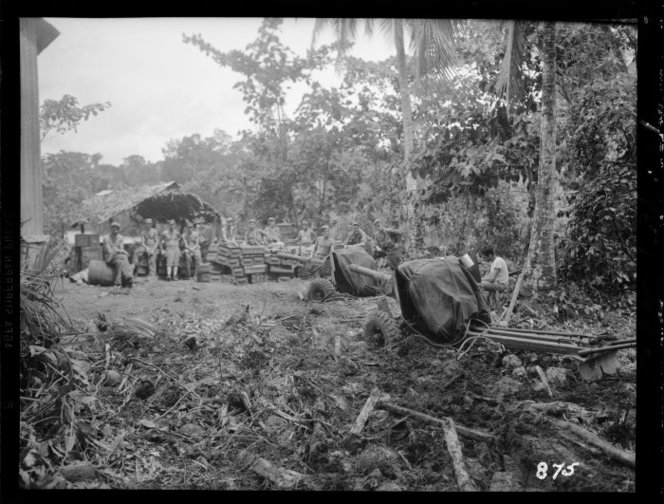 WH-0198B-F Vella Lavella Island. Soldiers of 3 New Zealand Division's 53 Anti-tank Regiment, resting after hauling their heavy guns through the mud of the jungle. Two guns can be seen with mud up to the axils. Photographed by an unknown photographer some time between 21 September and 9 October 1943. Inscriptions: Album page - left of image - I 875 Troops of 3 (NZ) Division in Vella Lavella. Gunners resting after hauling their heavy guns through the mud slush of the jungle. Official war photograph). 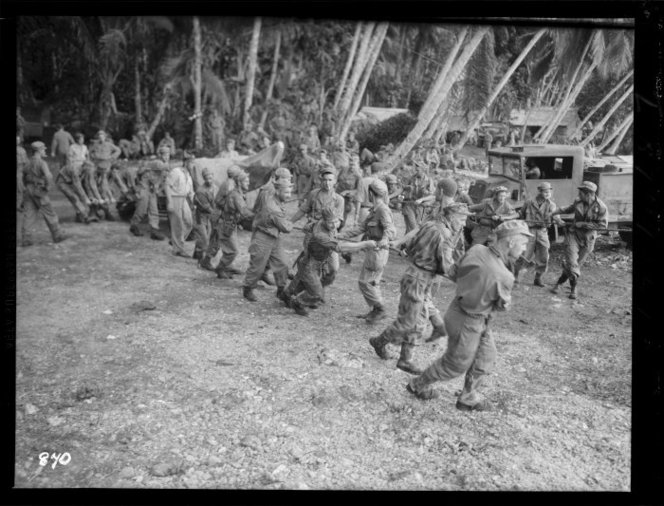 WH-0196-F Troops of the 3 (NZ) Division drag a piece of heavy artillery across the beach on Vella Lavella Island, Solomon Islands, to load it into a barge. Photograph taken 1943 during the Second World War. 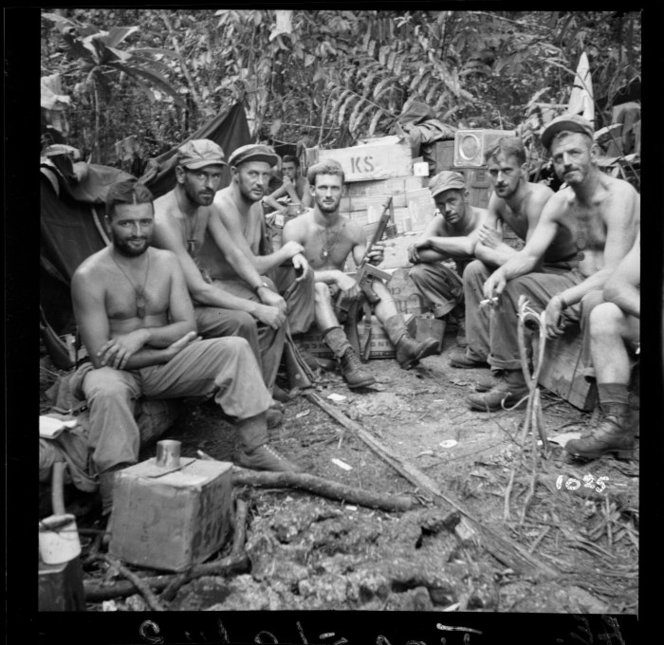 1/4-020427-F Ration dump at Tambama, Vella Lavella, Solomon Islands, 1943, during World War II operations. Shows soldiers alongside supplies. Third from left is Captain J F B Wilson. 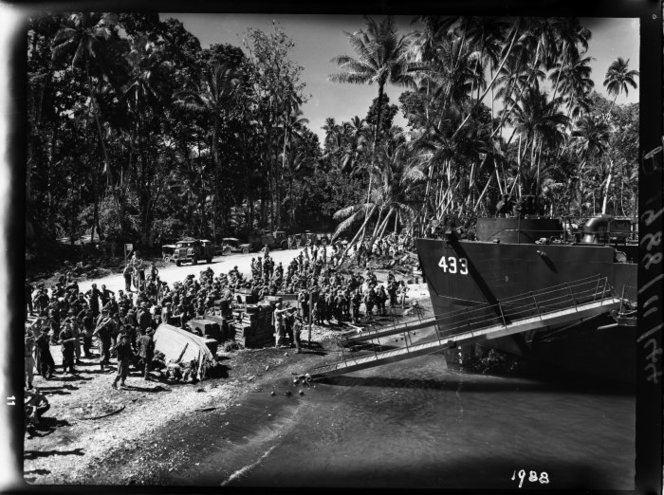 WH-0487-F World War 2 New Zealand troops, on Vella Lavella, Solomon Islands, preparing for the Green Island campaign, circa 1944. 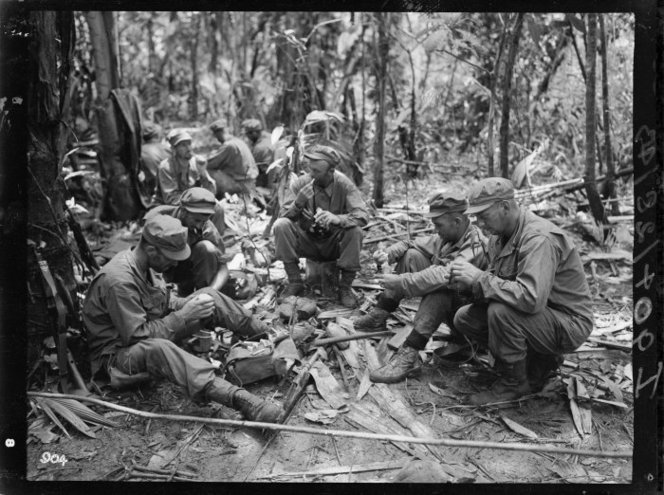 WH-0213-F Troops of 3 (NZ) Division on Vella Lavella Island, Solomon Islands, during World War II. The group of soldiers is sitting in the jungle, and a number of them are smoking. |
|
|
|
Post by Dave Homewood on Dec 29, 2019 16:27:21 GMT 12
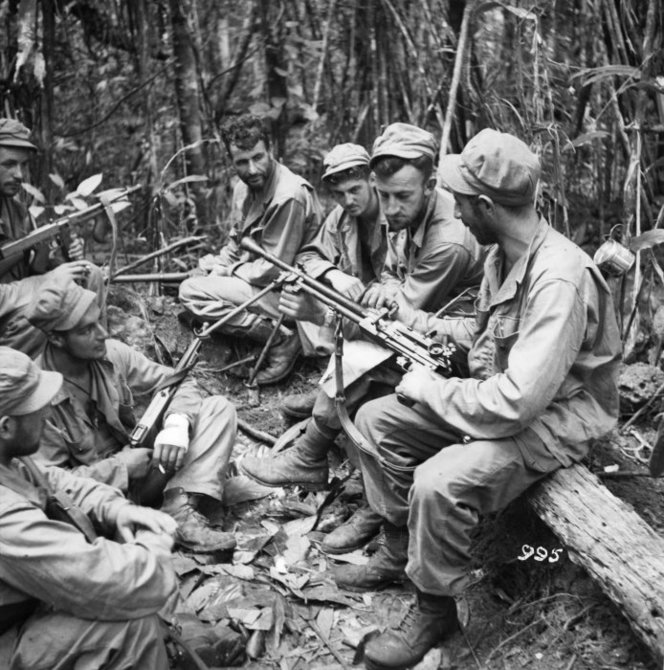 WH-0237 Interested New Zealand troops inspect a captured Japanese machine gun, Vella Lavella Island, World War 1939-1945 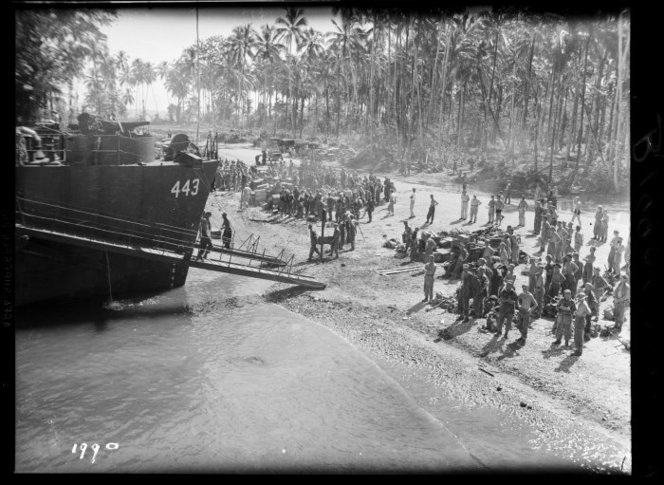 1/2-044734-F New Zealand World War 2 soldiers of 3rd Division, NZEF (IP) (in the Pacific) loading stores into LCIs (landing craft for infantry) at Vella Lavella, Solomon Islands, for the Nissan Island landing. Shows the landing craft beached at (Juno?) River, with troops and equipment on the beach alongside. Photograph taken in 1944. 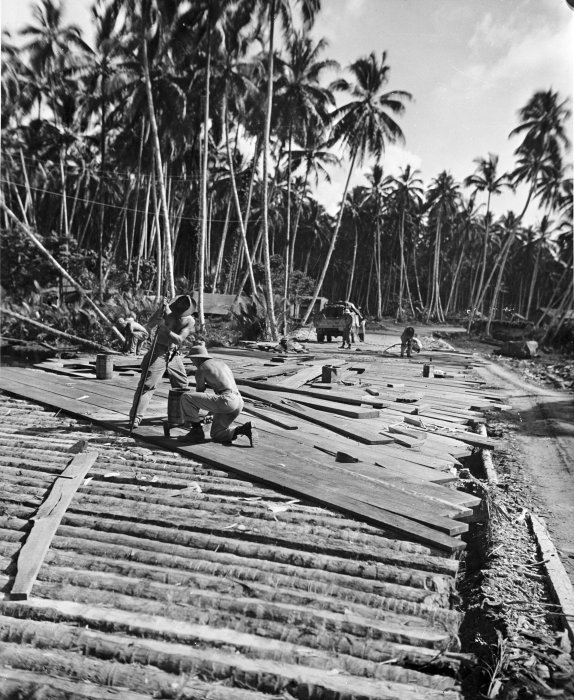 DA-00377-F World War 2 soldiers of 3 NZ Div Eng building a mahogany bridge. Official photograph. 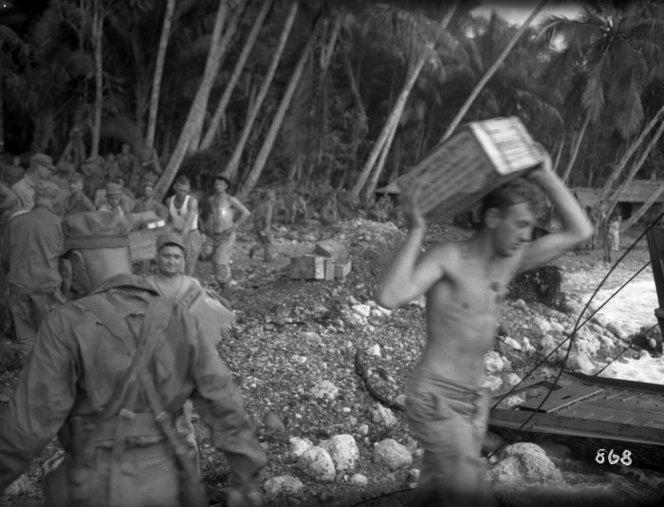 1/2-044802-F Soldiers loading rations into small landing craft for transport to men in action on the other side of the island. Taken in 1943 on Vella Lavella Island, Solomon Islands. 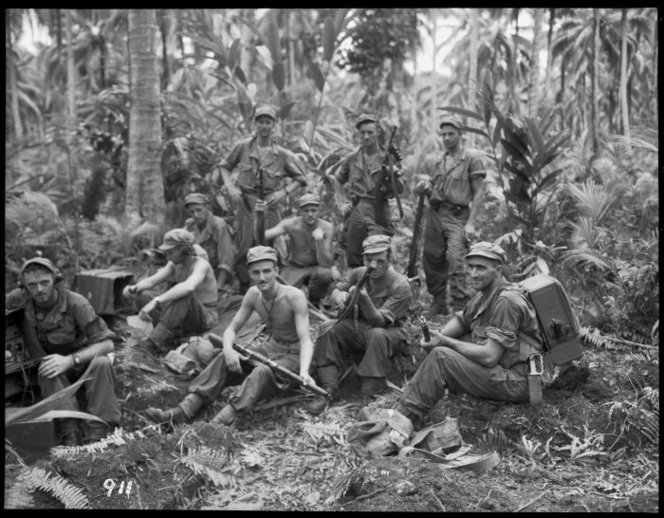 WH-0216-F World War 2 New Zealand troops, of 3rd New Zealand Division, 2nd New Zealand Expeditionary Force in the Pacific, Vella Lavella, Solomon Islands, circa 1943. |
|
|
|
Post by Dave Homewood on Dec 29, 2019 16:39:39 GMT 12
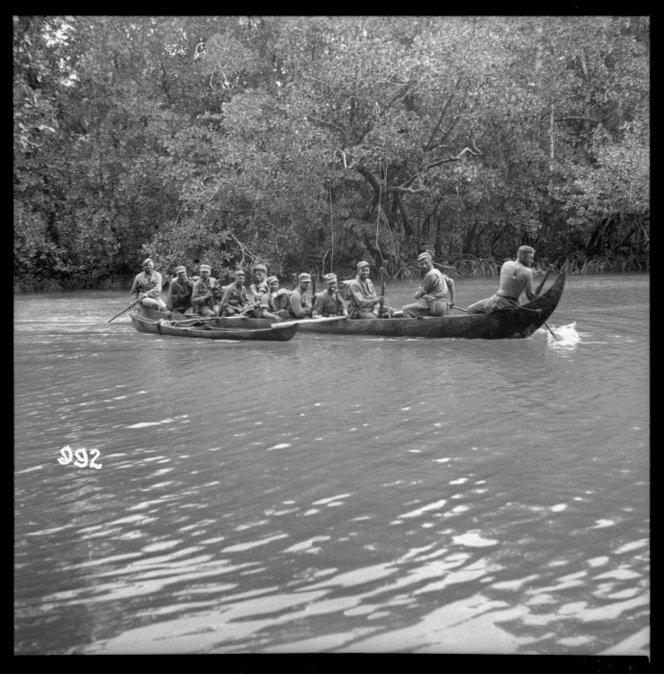 WH-0236-F Unidentified World War troops of the NZEF (IP) (New Zealand Expeditionary Force in the Pacific) using canoes for transportation on Vella Lavella, Solomon Islands, circa 1942-1945. 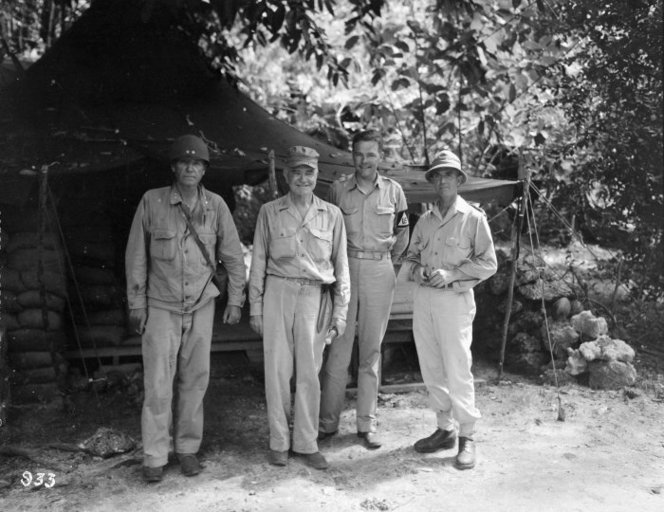 WH-0227-F Admiral Halsey photographed visiting the New Zealand Head Quaters on Vella Lavella Island 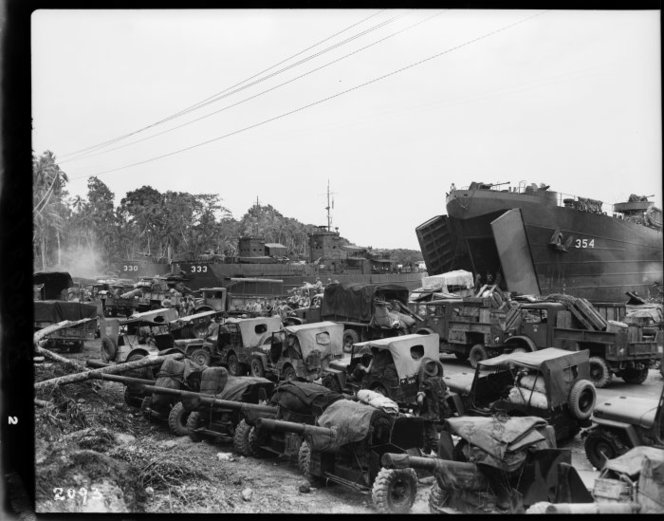 WH-0528-F Third echelon, 2nd New Zealand Expeditionary Force, loading at Juno River, Vella Lavella, during World War 2. Photographer unidentified. Juno River not listed in Times Atlas or in Pacific 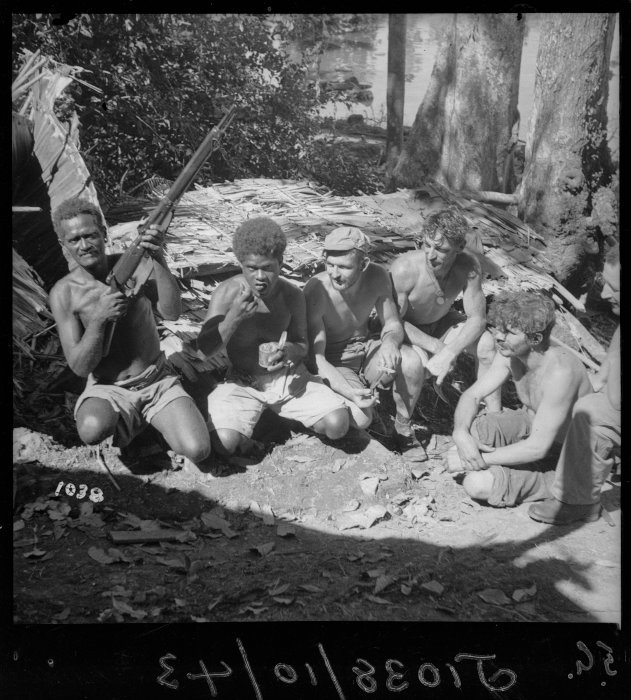 WH-0248-F World War 2 New Zealand troops, of 3rd New Zealand Division, 2nd New Zealand Expeditionary Force in the Pacific, with local guides, Vella Lavella, Solomon Islands, circa 1942-1945. One of the guides holds a captured Japanese rifle. All persons, and photographer, unidentified. 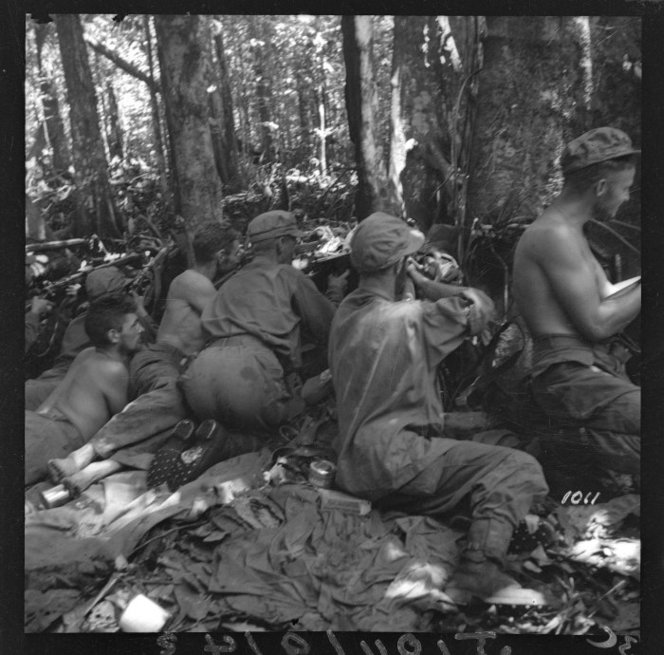 WH-0243-F World War 2 New Zealand troops, of the 14th Infantry Brigade, 3rd New Zealand Division, 2nd New Zealand Expeditionary Force in the Pacific, in action on Vella Lavella, Solomon Islands, circa 1942-1945. |
|
|
|
Post by Dave Homewood on Dec 29, 2019 16:52:31 GMT 12
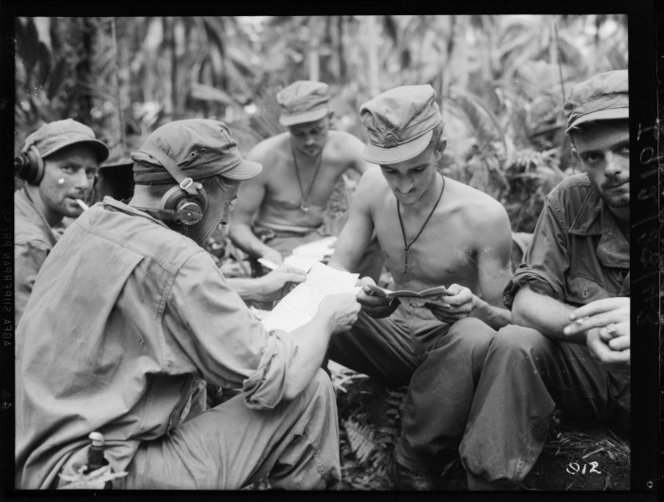 WH-0217-F New Zealand soldiers from 3rd Division reading letters from home at Vella Lavella, Solomon Islands, during World War II. Shows five men, sitting in a group in the jungle, resting behind the forward lines. 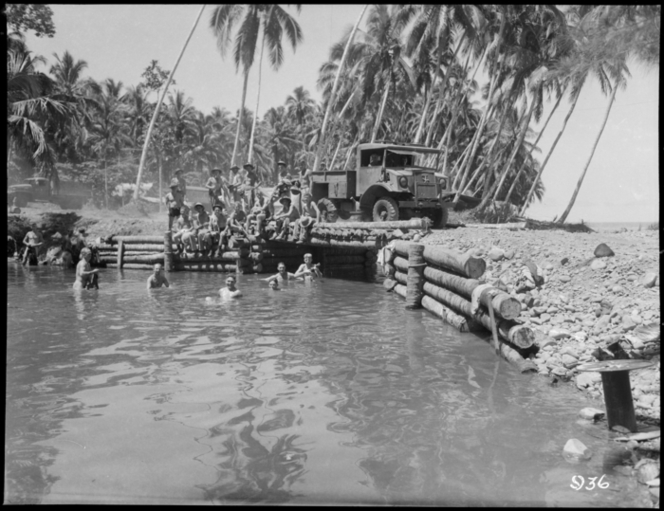 WH-0229-F Members of the New Zealand Expeditionary Force in the Pacific, during World War II, at Vella Lavella Island, Solomon Islands, circa 1944. Shows a group by a truck, with palm trees behind. Some are swimming. 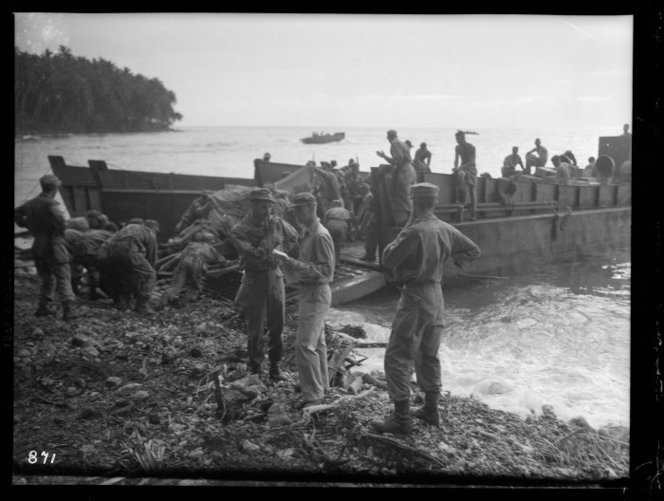 WH-0197-F World War II troops of 3 (NZ) Division checking equipment on Vella Lavella Island, Solomon Islands, circa 1944, before being moved north. 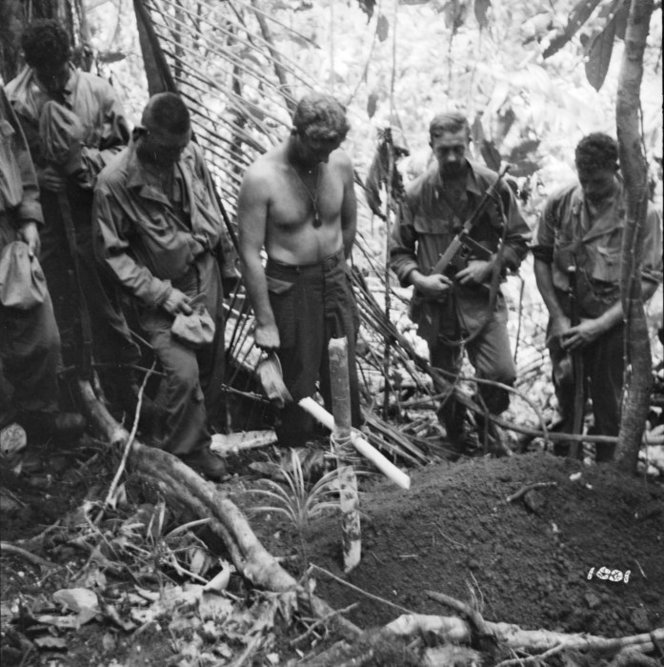 WH-0255-F Members of the 2nd New Zealand Expeditionary Force (in the Pacific) at a burial, Vella Lavella Island, Solomon Islands. 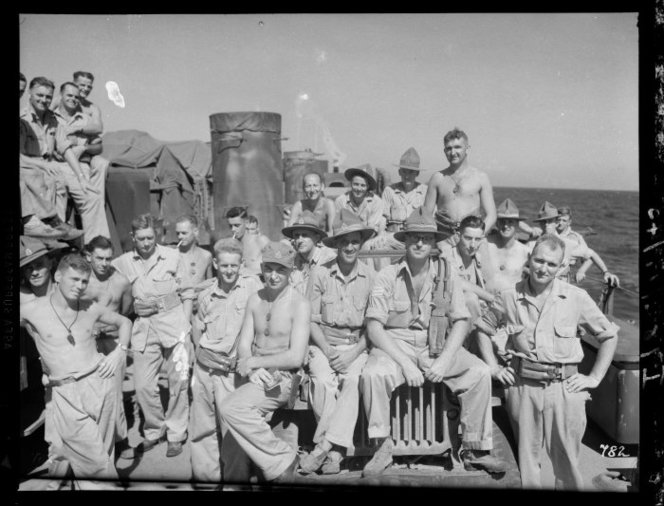 WH-0160-F Description New Zealand brigade on board ship, en route from Guadalcanal to Vella Lavella, Solomon Islands during World War II. |
|
|
|
Post by Dave Homewood on Dec 29, 2019 18:33:50 GMT 12
WAR IN THE JUNGLE
RETURNED MAN'S ACCOUNT
AUCKLAND, This Day.
A dramatic story of his experiences in the Vella LaveLa jungle was told by Private D. C. Murton. of Ellerslie,. invalided back from the combat area. He spoke of the live days' advance through dense jungle, and an ambush by a machine-gun section of Japanese marines. Wounded, lie spent three days struggling to reach the base with his brother's assistance. He attributed the New Zealand troops' success in the jungle largely to the lessons learned in training on Kaimai Ranges before they went overseas, but the jungle conditions were much more severe, containing many forms of strange life apart from the enemy. He gave a humorous account of experiences with land crabs and iguanas. At night, he said, the soldiers found it necessary to guard their personal articles, such as watches, one of which was carried off by a crab at night.
EVENING POST, 27 NOVEMBER 1943
|
|
|
|
Post by camtech on Dec 29, 2019 19:29:28 GMT 12
Agree, Dave, that not a lot is known of NZ Army operations in the Pacific. One of my uncles served in the Pacific as an anti-aircraft gunner, but wouldn't talk about his experiences. Always interested to read about these adventures.
|
|
|
|
Post by davidd on Dec 30, 2019 11:00:31 GMT 12
Yes, an intriguing batch of photographs, but one which particularly took my interest is the one located 13 from the bottom, image number "DA-00377-F", and titled as a "Mahogany bridge". Well, that name meant nothing to me and I was inclined to think that the fairly well-known term of "Corduroy road" was probably more correct. This type of road construction is sometimes credited to the famous Scottish road-builder John McAdam (1756 - 1836), but nevertheless somewhat similar types of roads are known to have been constructed as far back as 4,000 years BC, with the Romans also having constructed roads of this general type as required by circumstances, and availability of suitable logs. Most references describe the "Corduroy road" as a type of road or timber trackway made by placing transverse logs across the road when swampy or rough conditions rendered conventional roads impossible or useless. The one shown in this image has some improvements, including diagonally placed flat boards to make a far smoother road surface, as well as preventing disturbance of the underlying support logs. In earlier times, the inherent hazards presented by the simple corduroy road to beasts of burden or horses had to be taken into account, and the ultimate answer was to lay a similar decking of planks aligned along the length of the road. The "bridge" shown in this photo seems to run alongside a beach through a coconut plantation, perhaps to cross a small stream or marshy area as indicated by the bridge reference.
Most of the captions provided for these photographs leave much to be desired, and to me seem very naïve, no doubt because of lack of any detailed information in the first place, and scarcity of actual knowledge of the Pacific campaigns as well as technical subjects such as weapons and uniforms, among presumably young staff attempting to provide something of use to viewers. Guess I should not be too critical of the latter, as I have been placed in this sort of situation myself at times!
David D
|
|
|
|
Post by Dave Homewood on Dec 30, 2019 14:15:54 GMT 12
Yes, the captions are as they are on the website, not my captions.
I assumed that the mahogany referred to the type of timber being used as planking rather than construction method name.
|
|
|
|
Post by Dave Homewood on Dec 30, 2019 14:43:47 GMT 12
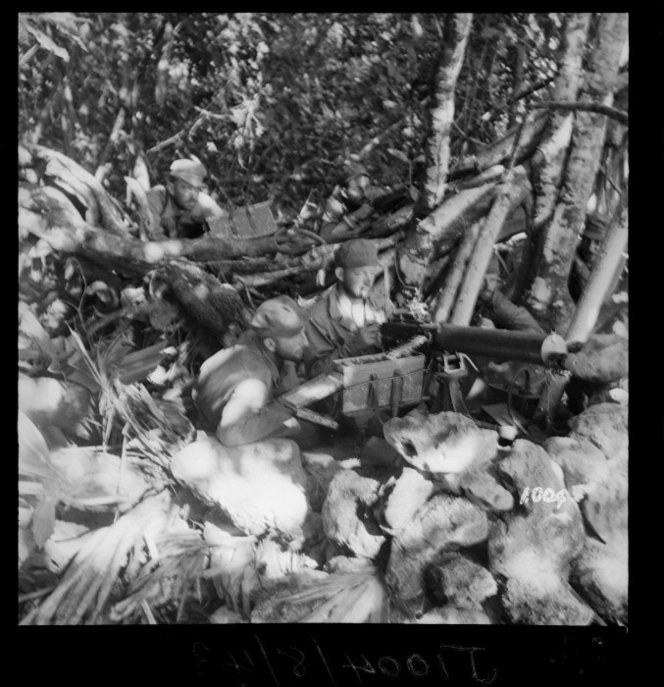 1/4-020431-F Lance-corporal Brewster and Private Walker behind their guns in the jungle at Vella Lavella, Solomon Islands, during World War II. Photograph taken in 1943 by an official photographer. 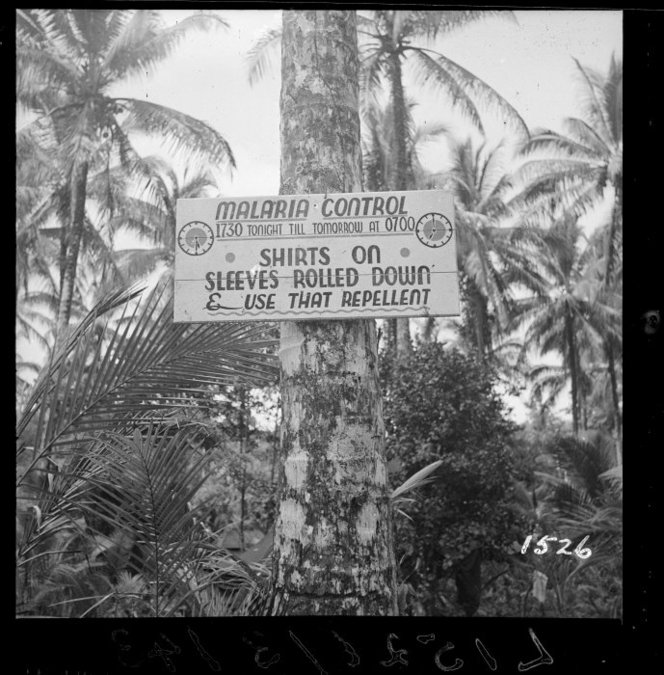 1/4-020417-F Malaria control sign attached to a tree at New Zealand Divisional Headquarters, Vella Lavella Island, Solomon Islands, during World War 2. Sign reads: "Malaria control 1730 tonight till tomorrow at 0700. Shirts on. Sleeves rolled down & use that repellent". Photograph taken in 1943 by an unidentified photographer. 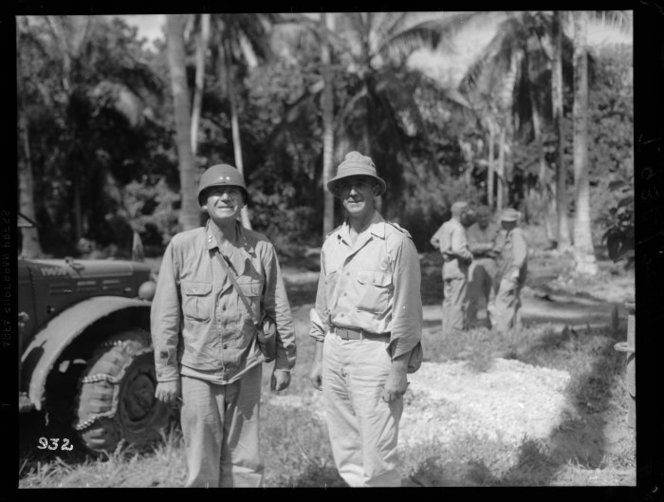 WH-0226-F Major General Harold Barrowclough, with General Griswald of the US Forces (on left) on Vella Lavella Island, Solomon Islands, during World War 2, circa 1943-1944. 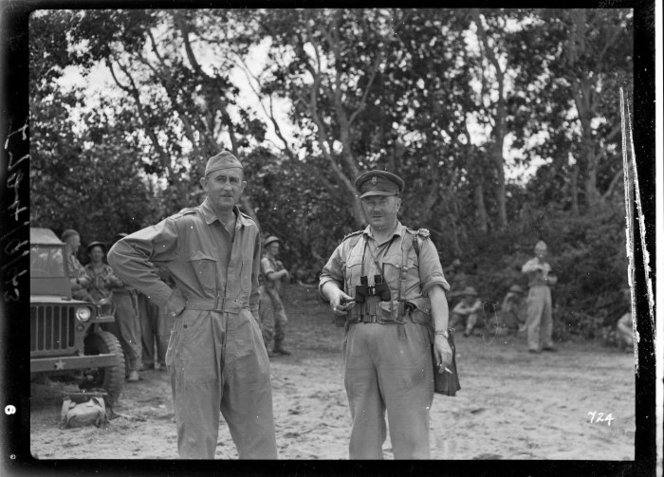 WH-0178-F Brigadier-General Neal C Johnson, United States Army, and Brigadier Robert Amos Row, New Zealand Army, at Vella Lavella, Solomon Islands, circa 1943, during World War II. Photograph taken by an unidentified official photographer. 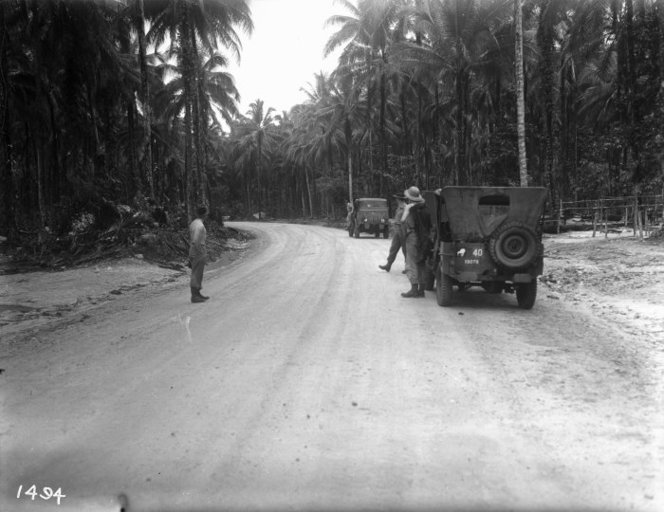 1/2-044784-F The Commander Regimental Engineers, inspecting a completed road between Barakoma and Joroneto, Vella Lavella Island, Solomon Islands, during World War 2. Image taken in 1943 by an unidentified photographer. |
|
|
|
Post by Dave Homewood on Dec 30, 2019 15:00:35 GMT 12
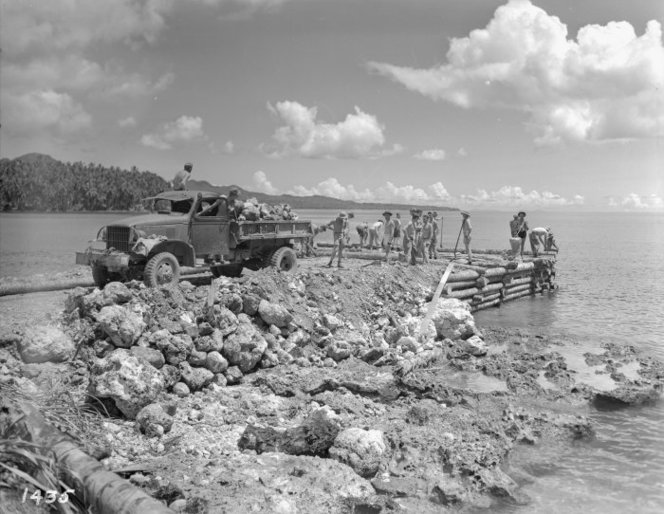 1/2-044776-F Military truck, and a jetty built by World War 2 New Zealand soldiers of the 20th Field Company, Maravari, Vella Lavella, Solomon Islands. Photographer unidentified. 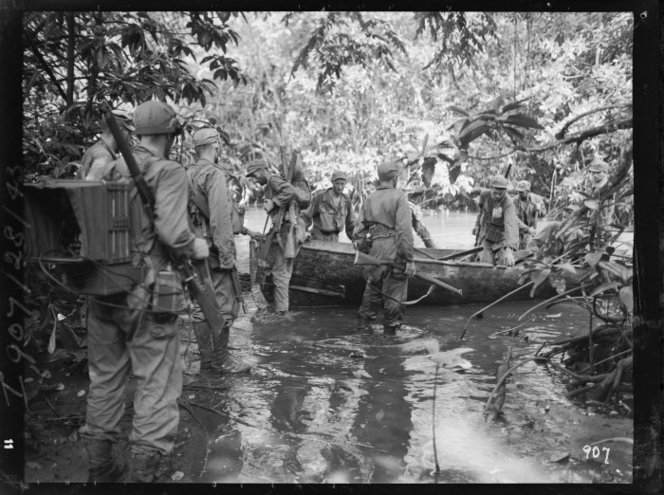 WH-0215-F New Zealand soldiers of 3rd Division in Vella Lavella, Solomon Islands, during World War II, with a boat abandoned by the Japanese. Shows men standing in a river in the jungle, grouped around a row boat. Photograph taken between 1942-1945 by an unidentified official photographer. 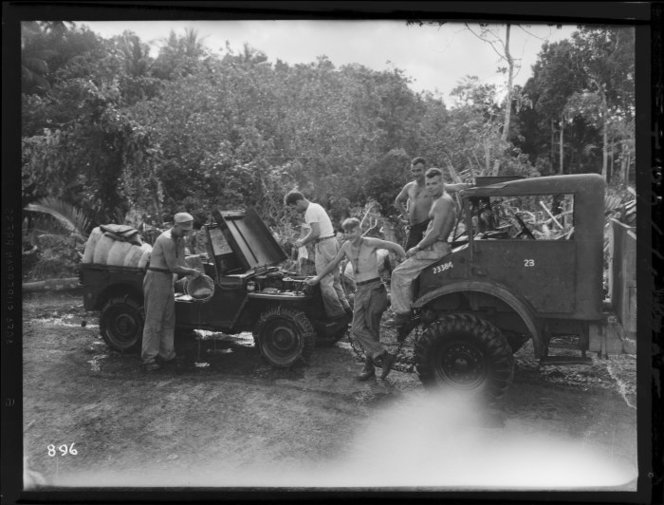 WH-0209-F New Zealand soldiers draining water from a jeep that was hauled from a stream, Vella Lavella, Solomon Islands, during World War II. Shows five men on the roadside, grouped around the vehicle. Photograph taken between 1942-1945 by an unidentified official photographer 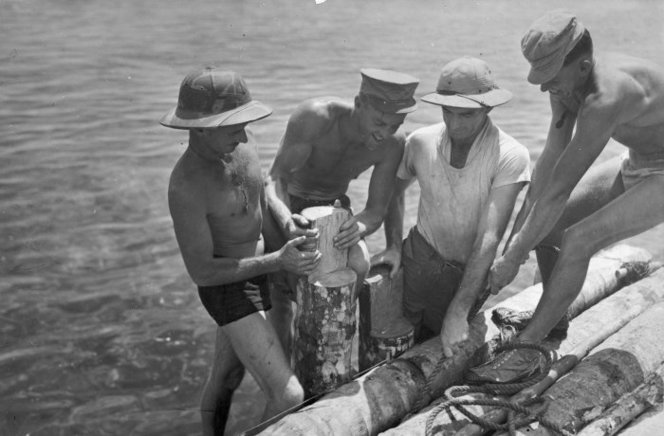 WH-0342-F Engineers from the 2nd NZEF IP (in the Pacific) building a landing jetty at Maravari, Vella Lavella Island, Solomon Islands, circa 1942-1945. From left: Sappers E T Baldwin (Hastings), M E Barnard (Hamilton), J W Furey (Waihi), and M G Ryan (Ak). Photographer unidentified. 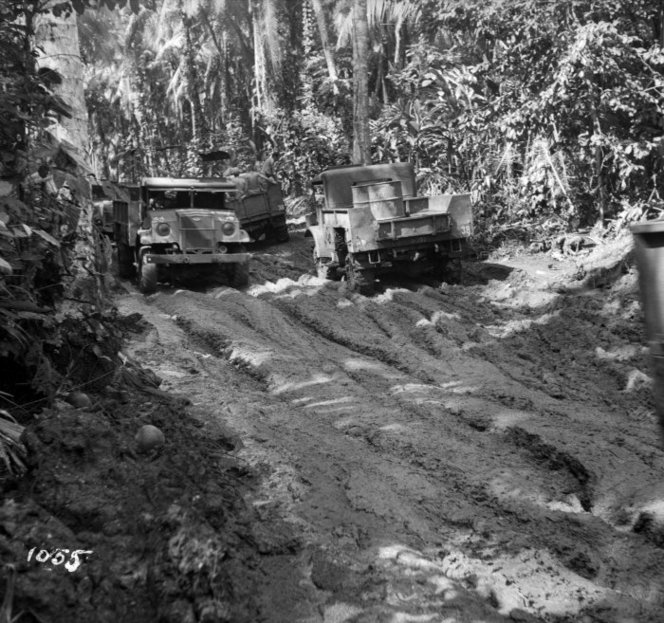 WH-0256 Army vehicles of the New Zealand Expeditionary Force on a muddy road in bush. Taken on Vella Lavella Island, Solmon Islands, during World War II. 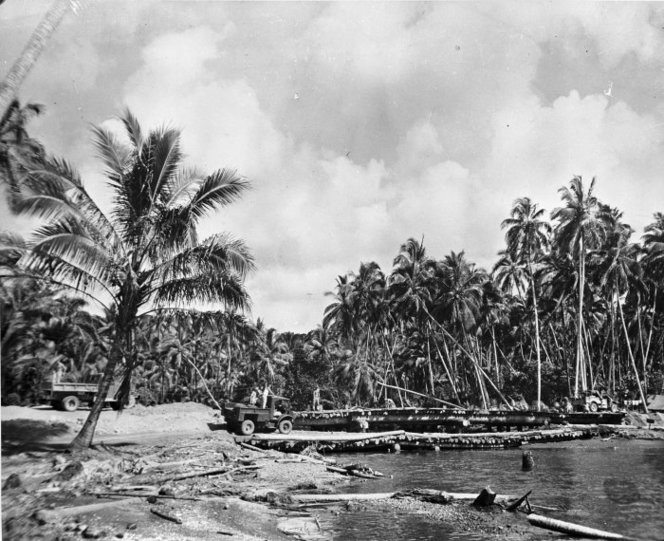 DA-00248-F Scene, with palm trees, at Vella Lavella, Solomon Islands, showing World War 2 soldiers of 3 NZ Div Eng building a mahogany bridge. Official photograph. |
|
|
|
Post by AussieBob on Jan 7, 2020 23:12:49 GMT 12
Dave, Here is some further reading on Vella Lavella from a U.S. perspective, the 6th Corps Combat Engineers. Among other things these guys brought ashore the NZ Bofors guns. It also has a photo of the Juno River bridge which one of the earlier image captions noted that Juno River wasn't found in an atlas.  |
|
|
|
Post by Dave Homewood on Jan 8, 2020 8:07:38 GMT 12
Thanks Bob. I wonder if Juno was an Allied-assigned code name rather than a local name?
|
|
|
|
Post by davidd on Jan 8, 2020 9:15:24 GMT 12
Same thought re the "Juno" name came to me Dave, as soon as I read it.
David D
|
|
|
|
Post by aircraftclocks on Jan 8, 2020 11:14:48 GMT 12
|
|




































